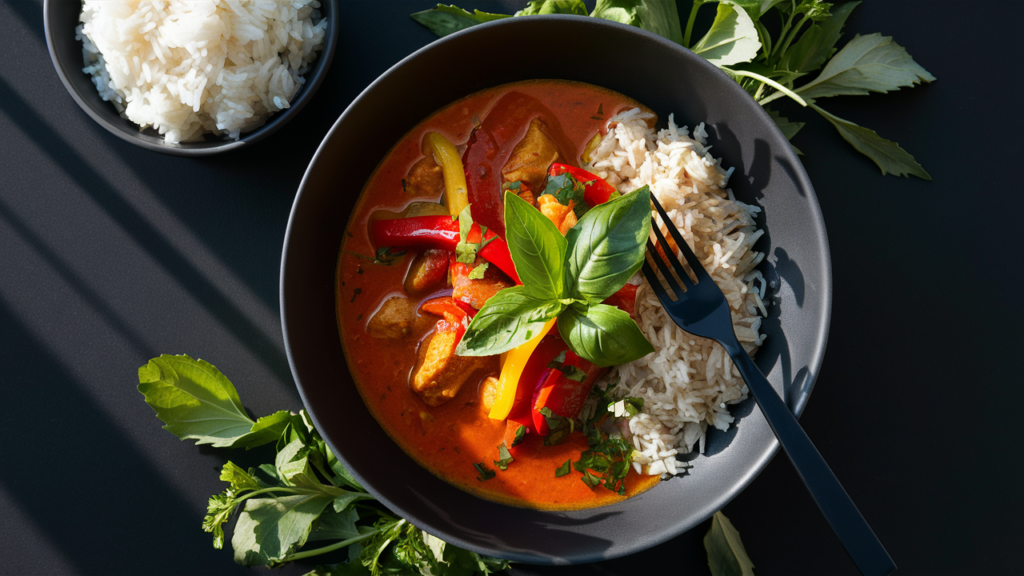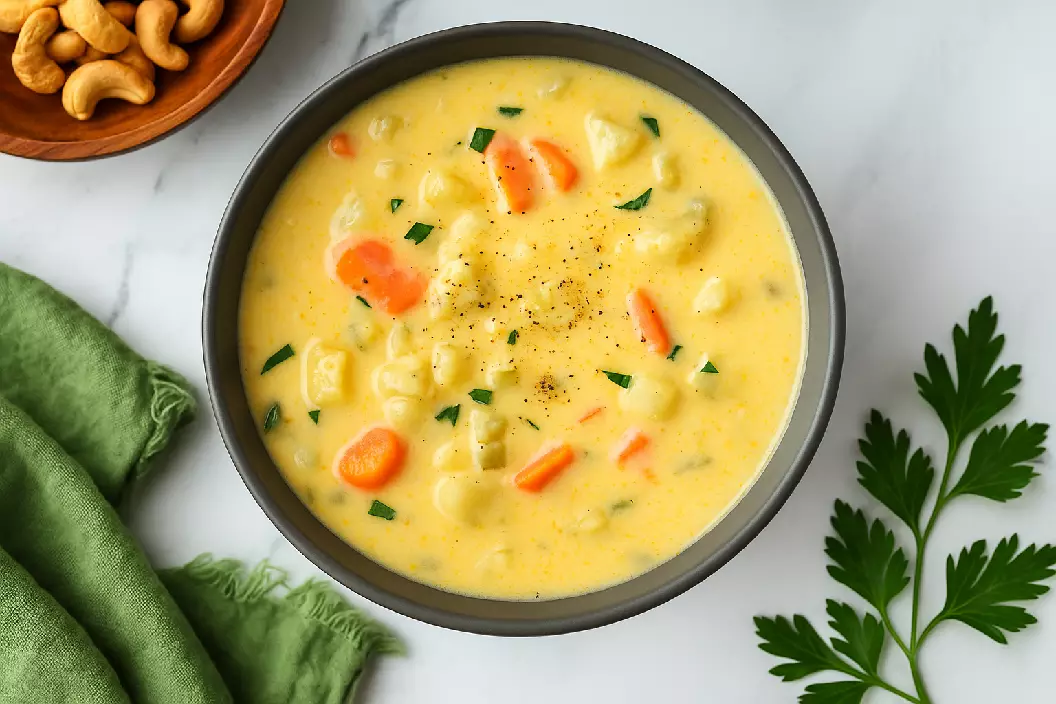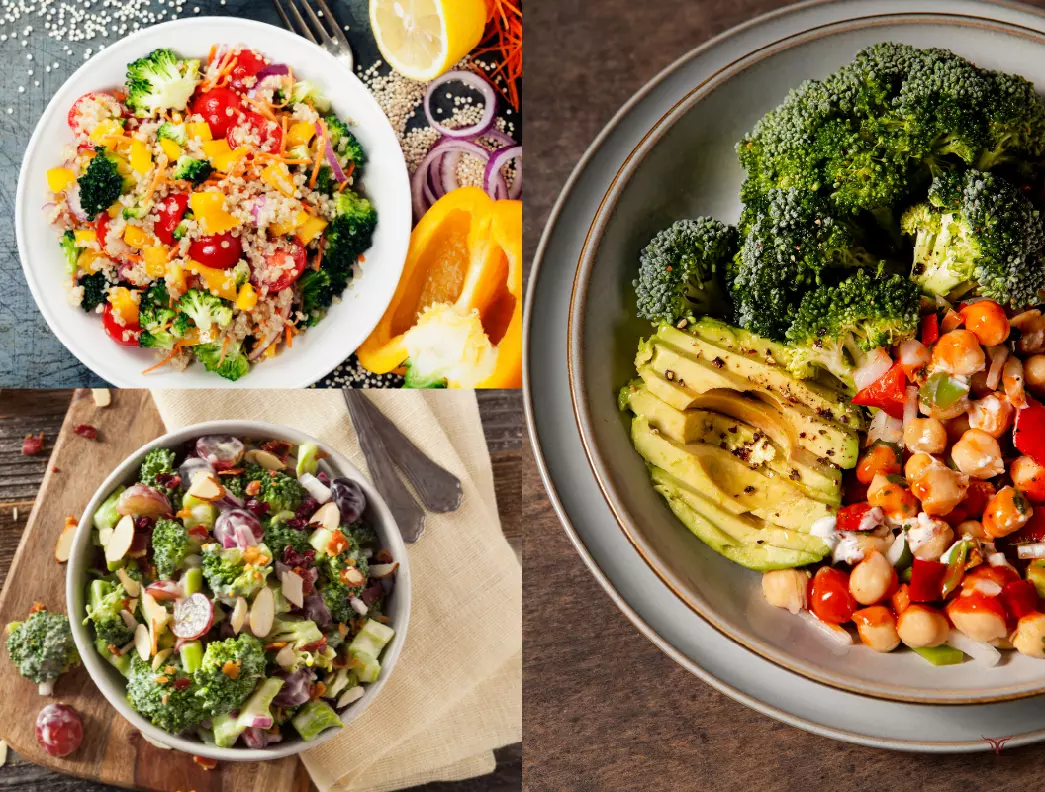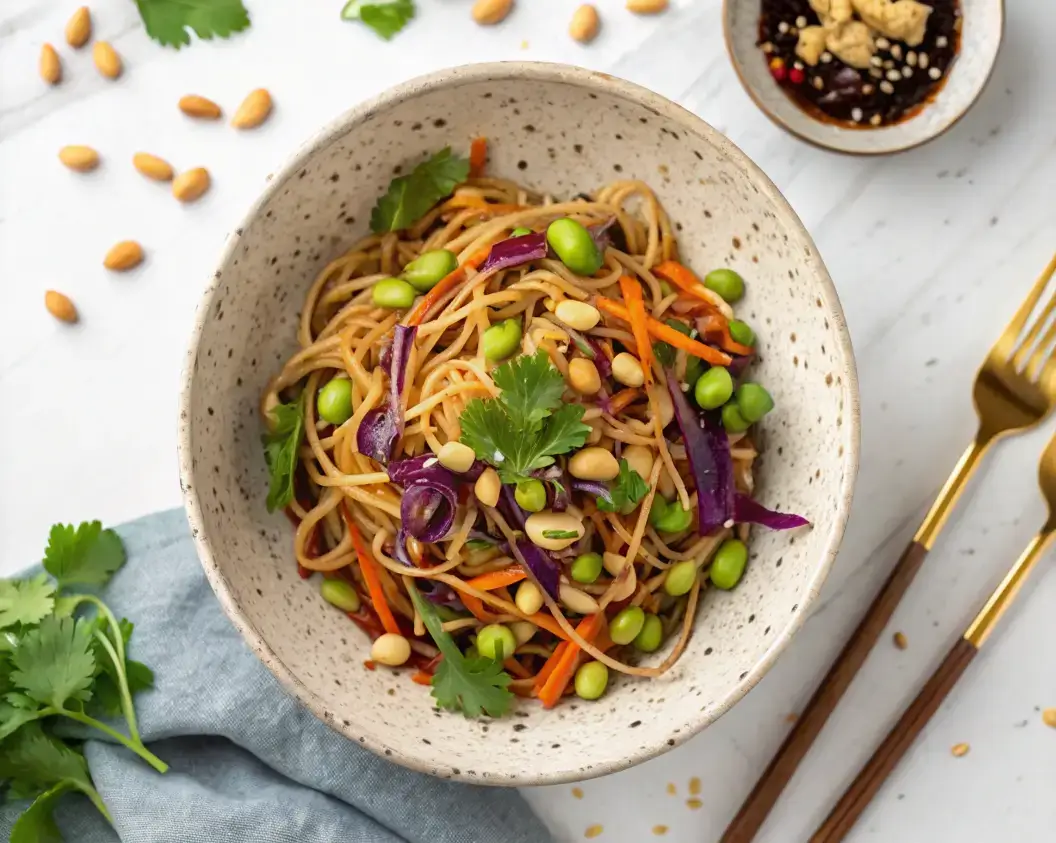Table of Contents
Have you ever tasted a Thai red curry recipe that transported you straight to the bustling streets of Bangkok? 🌶️ I know I have, and it’s an experience I’ll never forget. The rich, aromatic flavors dancing on my tongue, the perfect balance of spice and creaminess… it’s pure culinary magic. But here’s the thing: for years, I thought recreating that authentic taste at home was impossible.
I used to stare longingly at those little jars of pre-made curry paste in the supermarket, wondering if they could ever do justice to the real deal. Spoiler alert: they couldn’t. 😕 That’s when I decided to take matters into my own hands and master the art of homemade Thai red curry. And let me tell you, it’s been a game-changer for my taste buds and my confidence in the kitchen.
In this blog post, I’m going to share everything I’ve learned on my journey to curry perfection. We’ll dive into the essential ingredients that give Thai red curry its distinctive flavor, explore the best ways to prep your veggies for maximum deliciousness, and walk through the curry-making process step by step. Plus, I’ll reveal my secret tips for customizing your curry to suit your taste buds.
So, whether you’re a curry novice or a seasoned pro looking to up your game, stick around – your ticket to Thai curry nirvana awaits! 🍛✨
Essential Ingredients for Authentic Thai Red Curry Recipe

A. Red curry paste: The heart of the dish
Red curry paste is the soul of any authentic Thai red curry. I always make sure to use a high-quality paste, whether store-bought or homemade. Here’s a quick comparison of store-bought vs. homemade paste:
| Aspect | Store-bought | Homemade |
|---|---|---|
| Convenience | High | Low |
| Flavor control | Limited | Full |
| Shelf life | Longer | Shorter |
| Authenticity | Varies | High |
For homemade paste, I blend these key ingredients:
- Red chilies
- Lemongrass
- Galangal
- Shallots
- Garlic
- Kaffir lime leaves
B. Coconut milk: Creamy base for the curry
I always opt for full-fat coconut milk to achieve that rich, creamy texture. It’s the perfect canvas for the vibrant flavors of the curry paste. When cooking, I start by simmering the coconut milk before adding other ingredients.
C. Fresh vegetables: Adding nutrition and texture
My go-to vegetables for Thai red curry include:
- Bell peppers
- Eggplant
- Bamboo shoots
- Thai basil
I love how these veggies absorb the curry flavors while maintaining their texture. For a quick 30-minute meal, I sometimes use pre-cut stir-fry vegetables.
D. Aromatics: Enhancing flavors with herbs and spices
To elevate my Thai red curry, I always include these aromatics:
- Kaffir lime leaves
- Fresh ginger
- Thai basil
- Brown sugar (for balance)
- Lime zest and juice
These ingredients add depth and complexity to the curry sauce. I find that a dash of soy sauce can also enhance the umami flavor.
Preparing Your Vegetables for Maximum Flavor

Choosing the right mix of veggies
When I make Thai red curry, I love to use a colorful mix of vegetables. My go-to combination includes bell peppers, zucchini, and eggplant. These veggies not only add vibrant colors but also absorb the flavors of the curry beautifully. I also like to throw in some crisp snow peas for added texture and a pop of green.
Here’s a quick guide to my favorite veggies for Thai red curry:
| Vegetable | Texture | Flavor Profile |
|---|---|---|
| Bell Peppers | Crisp | Sweet |
| Zucchini | Tender | Mild |
| Eggplant | Soft | Earthy |
| Snow Peas | Crunchy | Fresh |
Proper cutting techniques for even cooking
To ensure all my vegetables cook evenly, I pay close attention to how I cut them. Here are my tips:
- Bell peppers: I cut them into 1-inch squares
- Zucchini: I slice them into half-moons about 1/4 inch thick
- Eggplant: I cube them into 1-inch pieces
- Snow peas: I leave these whole, just trimming the ends
Pre-cooking dense vegetables for perfect texture
For vegetables like eggplant that tend to take longer to cook, I often pre-cook them. This ensures they’re perfectly tender when the curry is ready. Here’s my method:
- I lightly salt the eggplant cubes and let them sit for 15 minutes
- Then, I pat them dry and stir-fry them in a little oil until they’re lightly browned
- I set them aside and add them back to the curry towards the end of cooking
This pre-cooking step helps the eggplant absorb less oil and maintain its shape in the curry. Now that my vegetables are prepped, I’m ready to start making my Thai red curry sauce.
Mastering the Curry-Making Process

Creating a flavorful base with aromatics
I always start my Thai red curry with a fragrant base of aromatics. I heat some oil in a large pan and add finely chopped onions, minced garlic, and grated ginger. The sizzling sound and aroma that fill my kitchen are incredible!
I sauté these ingredients until they’re soft and golden, which usually takes about 5 minutes. This step is crucial for building depth in my curry.
Incorporating the curry paste for optimal taste
Next, I add the star of the show – the red curry paste. I use about 2-3 tablespoons, depending on how spicy I want my curry.
I stir it into the aromatics and cook for another 2-3 minutes. This helps to bloom the spices and release their flavors. Here’s a quick guide to adjusting spice levels:
| Spice Level | Amount of Curry Paste |
|---|---|
| Mild | 1-2 tablespoons |
| Medium | 2-3 tablespoons |
| Hot | 3-4 tablespoons |
Adding coconut milk: Achieving the right consistency
Now, it’s time for the coconut milk. I always use full-fat coconut milk for a rich, creamy texture. I pour it in slowly, stirring constantly to incorporate it with the curry paste. The color transforms into a beautiful orange-red, and the aroma is simply irresistible!
Simmering vegetables to perfection
With my sauce ready, I add my prepared vegetables. My favorite combination includes:
- Bell peppers (red and yellow for color)
- Zucchini
- Carrots
- Bamboo shoots
I let everything simmer gently for about 10-15 minutes, or until the vegetables are tender but still have a slight crunch.
Balancing flavors with seasonings
Finally, I balance the flavors. I add:
- A splash of soy sauce for saltiness
- A squeeze of lime juice for acidity
- A touch of brown sugar for sweetness
I taste and adjust until it’s perfect. Now, my Thai red curry is ready to serve over jasmine rice!
Serving and Pairing Your Thai Red Curry

Ideal rice options for accompaniment
When it comes to serving my Thai red curry, I always opt for jasmine rice. Its delicate floral aroma and slightly sticky texture make it the perfect companion. However, I’ve found that brown rice can be a great alternative for a nuttier flavor and added fiber. Here’s a quick comparison of rice options:
| Rice Type | Texture | Flavor | Cooking Time |
|---|---|---|---|
| Jasmine | Fluffy | Floral | 15-20 mins |
| Brown | Chewy | Nutty | 35-40 mins |
| Basmati | Light | Aromatic | 15-20 mins |
Garnishes to elevate presentation and taste
To take my Thai red curry to the next level, I love adding these garnishes:
- Fresh cilantro leaves
- Thinly sliced kaffir lime leaves
- Chopped peanuts for crunch
- A wedge of lime for a zesty squeeze
These additions not only enhance the visual appeal but also add layers of flavor and texture to the dish.
Beverage pairings to complement the curry
When it comes to drinks, I find these options pair wonderfully with Thai red curry:
- Thai iced tea: Its sweetness balances the spice
- Coconut water: Refreshing and complements the coconut milk in the curry
- Light lager beer: Cleanses the palate between bites
Now that we’ve covered serving suggestions, let’s explore some tips for customizing your Thai red curry to suit your taste preferences.
Tips for Customizing Your Thai Red Curry

Adjusting spice levels to suit your taste
When it comes to Thai red curry, I believe that the perfect level of spiciness is a personal choice. Here’s how I customize my curry’s heat:
- Start with less: I begin with a small amount of curry paste and gradually add more to taste.
- Use coconut milk: I balance the heat by adding more coconut milk for a milder flavor.
- Add fresh chilies: For an extra kick, I thinly slice fresh Thai chilies and add them at the end.
- Incorporate sweet elements: I use brown sugar or palm sugar to offset the spiciness.
| Spice Level | Curry Paste Amount | Additional Heat Options |
|---|---|---|
| Mild | 1-2 tbsp | None |
| Medium | 2-3 tbsp | 1-2 fresh chilies |
| Hot | 3-4 tbsp | 3-4 fresh chilies |
Protein additions for a heartier meal
To make my Thai red curry more substantial, I often add protein. Here are my go-to options:
- Chicken: I use bite-sized chicken breast or thigh pieces.
- Shrimp: Large, peeled shrimp work wonderfully in curry.
- Tofu: For a vegetarian option, I add firm tofu cubes.
- Fish: I sometimes incorporate white fish fillets, cut into chunks.
Vegetarian and vegan adaptations
I love how versatile Thai red curry recipe can be for different dietary needs. Here’s how I make it vegetarian or vegan:
- Replace fish sauce with soy sauce or tamari for umami flavor.
- Use vegetable broth instead of chicken broth.
- Add extra vegetables like bell peppers, eggplant, or bamboo shoots.
- Incorporate plant-based proteins like tempeh or seitan.
For a creamier vegan version, I make sure to use full-fat coconut milk. These adaptations ensure that everyone can enjoy this delicious Thai dish, regardless of their dietary preferences.
FAQ
Can I make Thai red curry ahead of time?
Yes, you can make Thai red curry ahead of time. In fact, I find that the flavors often deepen and meld together even more when left overnight. Here’s a quick guide:
- Cook the curry as usual
- Let it cool completely
- Store in an airtight container in the refrigerator
- Reheat gently on the stove, adding a splash of coconut milk if needed
| Storage Method | Duration | Notes |
|---|---|---|
| Refrigerator | 3-4 days | Best flavor |
| Freezer | 2-3 months | May affect vegetable texture |
Is Thai red curry always spicy?
Not necessarily. The spice level can vary greatly depending on the amount of red curry paste used. I can adjust the heat to my preference:
- Mild: Use less curry paste, add more coconut milk
- Medium: Follow the recipe as written
- Hot: Increase curry paste, add fresh chilies
Can I use store-bought curry paste?
Absolutely! While I love making homemade curry paste, store-bought versions are convenient and often quite good. Look for brands like Thai Kitchen for an authentic taste. Just remember, the quality of your curry paste significantly impacts the final dish.
What’s the best rice to serve with Thai red curry?
I prefer jasmine rice for its aromatic qualities and ability to soak up the curry sauce. However, here are some other options:
- Brown rice for added nutrition
- Cauliflower rice for a low-carb option
- Rice noodles for a different texture
Remember, the key is to have something to soak up that delicious curry sauce!
I hope this Thai Red Curry recipe has inspired you to bring the vibrant flavors of Thailand into your kitchen. From gathering the essential ingredients to mastering the curry-making process, we’ve covered all the steps to create a delicious and authentic dish. Remember, the key to a great Thai Red Curry lies in the balance of flavors and the freshness of your vegetables.
As you embark on your Thai cooking journey, don’t be afraid to experiment and make the recipe your own. Try different vegetables, adjust the spice level, or even add your favorite protein.
The beauty of Thai Red Curry is its versatility. So, grab your wok, gather your ingredients, and let’s start cooking! Your taste buds will thank you for this flavorful adventure.
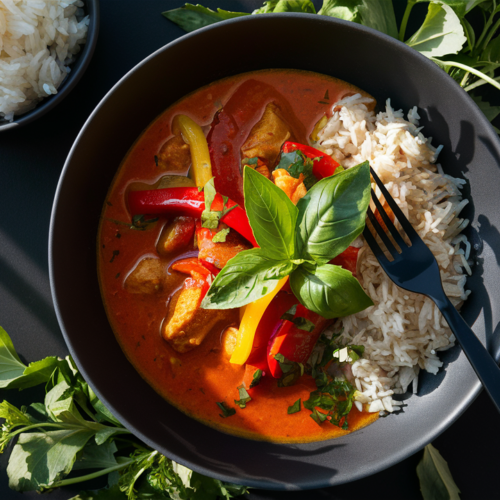
15-Minute Thai Red Curry Recipe: Vegan and Easy to Make
Ingredients
- 2-3 tablespoons Thai red curry paste
- 2 14 oz cans full-fat coconut milk
- 1 red bell pepper cut into 1-inch squares
- 1 yellow bell pepper cut into 1-inch squares
- 1 medium eggplant cubed
- 2 cups bamboo shoots
- 1 zucchini sliced into half-moons
- 1 cup snow peas trimmed
- 3 tablespoons soy sauce
- 2 tablespoons brown sugar
- 2-3 kaffir lime leaves
- 1 tablespoon fresh ginger grated
- 4 cloves garlic minced
- 1 onion finely chopped
- Fresh Thai basil leaves
- Lime juice from 1 lime
- 2 cups jasmine rice for serving
Instructions
- Cook jasmine rice according to package instructions.
- Salt eggplant cubes and let sit for 15 minutes. Pat dry and pre-cook in oil until lightly browned.
- Heat oil in a large wok over medium heat. Add onions, garlic, and ginger. Sauté for 5 minutes.
- Add red curry paste and cook for 2-3 minutes until fragrant.
- Pour in coconut milk slowly, stirring constantly.
- Add bell peppers, zucchini, bamboo shoots, and snow peas.
- Simmer for 10-15 minutes until vegetables are tender-crisp.
- Add pre-cooked eggplant, soy sauce, brown sugar, and lime juice.
- Taste and adjust seasonings.
- Serve hot over jasmine rice, garnished with Thai basil.
Notes
- Make it spicier by adding 1-2 fresh Thai chilies
- Store in refrigerator for up to 3-4 days
- Freeze for up to 2-3 months
- For protein variation, add tofu, tempeh, or seitan
- Use full-fat coconut milk for best results
- Customize vegetables based on availability
Rate this recipe and share your results!
There are no reviews yet. Be the first one to write one.

